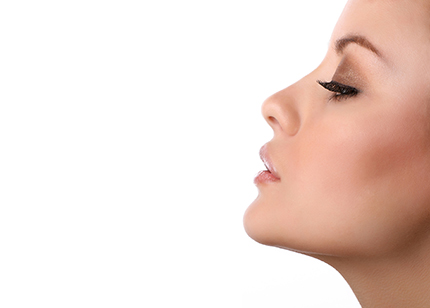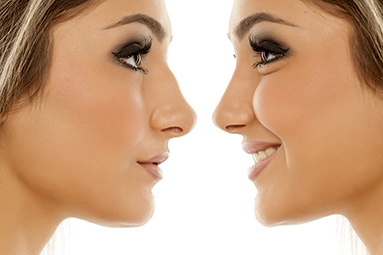Cosmetic Procedures
Thread Lift
The thread lift is a minimally invasive in office procedure where temporary sutures are used to produce a subtle lift in the midface. Unlike a facelift, where skin is incised and a large incision is made, a tiny entry site is made and the MINT™ suture thread is advanced under the skin to suspend, lift and tighten the cheeks and jowls. The procedure is quick and takes about 30-45 minutes in clinic. Although the threads are dissolvable sutures and tend to dissolve by about 6 months, they have the added benefit of triggering collagen production in the face. Collagen keeps our skin looking healthy and fresh and supports our skin and extends the results of the thread beyond 1 year, long after the sutures have absorbed. For more information, click here.
Face Lift and Neck Lift
A facelift can be performed using a number of different techniques. This can include the degree of undermining (or freeing the skin from the underlying tissues), the depth of dissection (SMAS, sub-SMAS, deep plane, skin only), the type of suture or suspension that is used to maintain the lift and ancillary procedures that may be necessary (e.g. chin augmentation, liposuction, autologous fat injection, filler injection, platysmaplasty). Irrespective of the technique that is used, the goal of a facelift is to achieve rejuvenation of the face and neck. This involves an incision that extends from the temporal hairline, around the ear and then blends into the hairline behind the ear. This incision is designed in such a way to minimize the resultant scar. Again, depending on the type of facelift that is chosen, the recovery period usually lasts 2 weeks, however the amount of swelling varies from one person to the next and can last for up to 4-6 weeks. The procedure itself usually takes 4-5 hours.

Brow Lift
Descent of the brow and forehead is another common reason for seeking consultation with a facial plastic surgeon. With time, the effects of gravity take its toll on the area above and around the eyes. There are a number of muscles around the brow and eye that cause wrinkles of the forehead and glabella (area between the eyebrows). These wrinkles coupled with a lowering of the position of the brow can lead to an unhappy or tired appearance. A browlift can be performed in a number of different ways including the coronal (incision behind the hairline), pre-trichial or trichophytic lift (incision designed around the hairline), mid-forehead (using an existing wrinkle in the forehead), direct (designing an incision immediately above the brow) or via an endoscopic approach (using 5 incisions hidden behind the hairline). These approaches vary in terms of the surgical technique and planes of dissection used during the procedure. Nonetheless, all of these approaches can be very effective in lifting the brow to the desired position without creating an “over-done” or “surgical” look. The recovery from a browlift is usually 1-2 weeks and the procedure takes 2-3 hours. Some people experience numbness of the scalp and headaches following procedures to address the brow and forehead.
Eyelid Surgery
Drooping of the upper eyelids can lead to a tired appearance and in some cases may even impair one’s vision. A blepharoplasty of the upper lid involves removing excessive skin to achieve a rejuvenated look of the upper eyelid. In the past, eyelid surgery resulted in a “hollowed-out” look of the upper eyelids, however current techniques aim to achieve a more youthful appearance of the eyelids. Upper Lid surgery usually take 60-90 minutes and the expected recovery usually lasts 7 days. The incision is closed with fine sutures that are removed at 5-7 days following the procedure. Additionally, fine surgical bandages may be applied to the upper lid in the period following the procedure. A small amount of bruising and swelling can be expected, and patient’s area usually placed on an ointment and/or eye drops following blepharoplasty.
Lower eyelids with an aged appearance may have visible bulging and bags, excessive skin and fine wrinkles. Surgery of the lower eyelids (Lower lid Blepharoplasty) can be done via a transcutaneous (incision beneath the eyelid to access the underlying muscle and fat) or transconjunctival approach (incision is made on the inside of the eyelid) depending on the needs of the individual. Dark bags under the eyes may be the result of allergies, or an abnormal deposit of pigment in the lower eyelid. These conditions are not corrected with surgery. Lower lid blepharoplasty improves the bulging quality of the lower eyelid by conservatively addressing the fat that may be bulging through the orbital septum (pseudoherniation of orbital fat). Moreover, this fat can be used to improve a prominent tear trough by repositioning the orbital fat (lower lid blepharoplasty with fat repositioning). Again, the procedure to be performed can be tailored to a patient’s individual needs and desires. Lower eyelid surgery takes approximately 2 hours and the recovery period is usually 7-10 days. As for upper eyelid surgery, bruising and swelling are common, however, if a patient is experiencing significant pain or vision changes, he or she should seek immediate medical attention.
Rhinoplasty
Functional Rhinoplasty

Many people experience a blocked nasal airway and the resultant difficulty breathing that accompanies this blockage. There are myriad causes of nasal airway obstruction, however there are a number of anatomic causes for this difficulty. This can include an obstructive nasal septum (link to septoplasty portion of site), collapse of the internal or external nasal valve, and post-traumatic deformities that may preclude normal function of the nose. The internal nasal valve is the narrowest portion of the nasal airway and may become obstructed as a result of trauma and/or prior surgery and is usually corrected with a type of graft known as a spreader graft that acts to widen the aperture or caliber of this space. The cartilage used for this purpose usually is taken from the septum that may be corrected at the time of the surgery. The external nasal valve is essentially comprised of the tissues composing the nostril or nasal aperture. In some cases, a patient’s anatomy is such that dynamic forces with inspiration lead to collapse of this area. Again, certain grafting techniques and or cartilage repositioning techniques can be used to correct this functional problem. Prior to any septorhinoplasty, a surgeon will thoroughly evaluate all aspects of the internal and external nasal airway and this will ultimately be the deciding factor in terms of the proposed surgical plan to correct the functional issue. In some cases, insurance carriers may cover, at least in part, the cost of functional rhinoplasty.
C osmetic Rhinoplasty
osmetic Rhinoplasty
If a patient is dissatisfied with the size and shape of his or her nose, a cosmetic rhinoplasty can be oftentimes be performed to improve the appearance of one’s nose. The goal of cosmetic rhinoplasty is to achieve this improvement by having a thorough and frank discussion with the patient in order to determine what is bothering him or her. Patients may note a hump on the bridge of the nose that is felt to be too prominent, disproportion of the overall nasal size compared to the rest of one’s face (i.e. nose is too large or small), a crooked or twisted nasal bridge, and/or asymmetries of the nose. Computer imaging and morphing software is frequently used to facilitate this discussion and serves as a visual tool to help the physician and patient articulate their goals and desires for the surgery. As above, the initial recovery period lasts 1-2 weeks, however post-operative swelling may last for weeks to months before the final surgical result can be seen.
Revision Rhinoplasty
Revision rhinoplasty is nasal surgery that is performed on a nose that has been previously operated upon. These surgeries can range from minor to major surgeries depending upon the needs and desires of an individual. In most cases, revision rhinoplasty is more difficult than primary (the initial operation) rhinoplasty. This is largely due to factors associated with scarring and wound healing. Additionally, the cartilage and bone may have been manipulated at the time of surgery in such a way that grafting (usually with cartilage) may be necessary to improve both the form and function of the nose. The recovery period for revision nasal surgery, especially with regards to post-operative swelling, is usually longer than in the case of an initial septorhinoplasty.

Hair Restoration
There are many effective nonsurgical options for hair restoration. These options are important both as stand-alone treatments and as adjunctive treatments to hair transplant. Rogaine is a treatment that has been in place for many years and can effectively augment the appearance of thickness of density to thinning areas. Propecia is an effective treatment for male patterned baldness. More recently, improvements in platelet rich plasma administration and low level laser light administration have significantly improved density and thickness in areas of thinning hair. These treatments are all important to administer during or after a hair transplant. They can really help to decrease the effects of shock loss and improve the ultimate hair transplant outcomes.
Hair Transplant
Hair transplant is an effective way to restore a natural and youthful hairline. In hair transplant, individual follicular units are harvested from areas in the scalp that are resistant to the action of DHT. Follicular units are hairs that naturally grow in 1 to 4 haired groups. Even patients with advanced balding will retain a strip of resistant hairs in the temporal and occipital regions. These hairs are resistant to miniaturization and retain this property when transplanted. These hairs serve as the donor hairs for transplant. One or more sessions may be required to achieve the desired result. Typically, one to two sessions is sufficient depending on degree of hair loss and the number of grafts needed.
- Follicular Unit Transplant: Also known as FUT, follicular unit transplant is an excellent technique to acquire high quality hair grafts for transplant. In FUT, a strip of hair is harvested from the occipital scalp. The hair is then expertly slivered into individual units and then transplanted in specially designed recipient sites.
- Follicular Unit Extraction: Also known as FUE, follicular unit extraction is gaining popularity. In this technique, a motorized punch is used to remove individual follicular units from the scalp. This technique requires expertise as individual hairs can easily be transected or damaged during harvesting and overall graft survival is lower. The individually extracted follicular units are then transplanted in specially designed recipient sites.
For more information click here.

 Call Us
Call Us